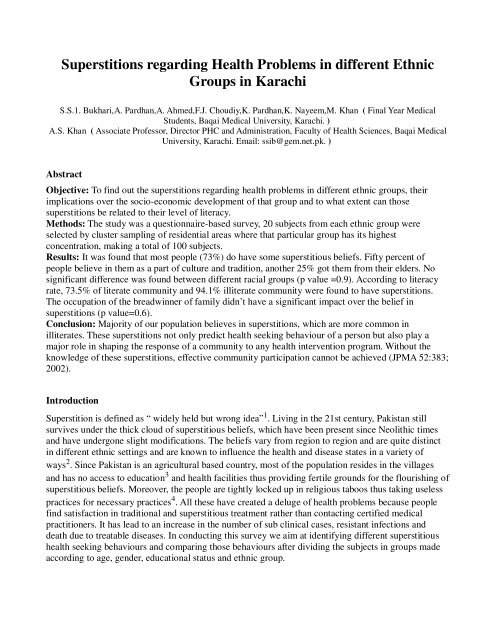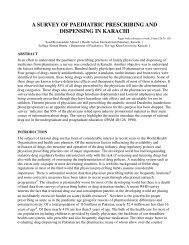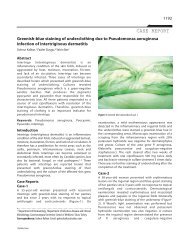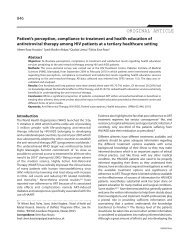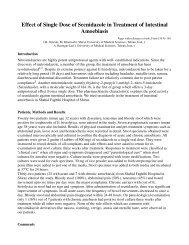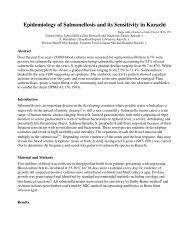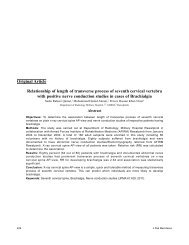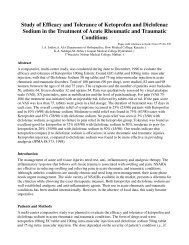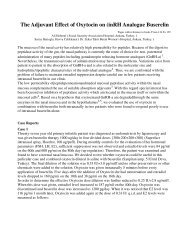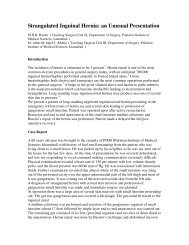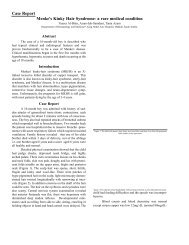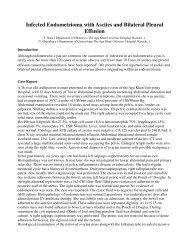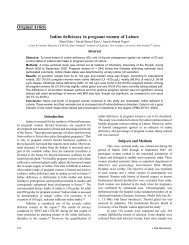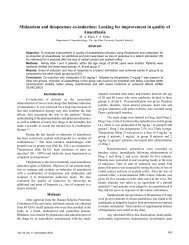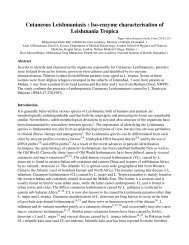Superstitions regarding Health Problems in different Ethnic Groups ...
Superstitions regarding Health Problems in different Ethnic Groups ...
Superstitions regarding Health Problems in different Ethnic Groups ...
You also want an ePaper? Increase the reach of your titles
YUMPU automatically turns print PDFs into web optimized ePapers that Google loves.
<strong>Superstitions</strong> <strong>regard<strong>in</strong>g</strong> <strong>Health</strong> <strong>Problems</strong> <strong>in</strong> <strong>different</strong> <strong>Ethnic</strong><br />
<strong>Groups</strong> <strong>in</strong> Karachi<br />
S.S.1. Bukhari,A. Pardhan,A. Ahmed,F.J. Choudiy,K. Pardhan,K. Nayeem,M. Khan ( F<strong>in</strong>al Year Medical<br />
Students, Baqai Medical University, Karachi. )<br />
A.S. Khan ( Associate Professor, Director PHC and Adm<strong>in</strong>istration, Faculty of <strong>Health</strong> Sciences, Baqai Medical<br />
University, Karachi. Email: ssib@gem.net.pk. )<br />
Abstract<br />
Objective: To f<strong>in</strong>d out the superstitions <strong>regard<strong>in</strong>g</strong> health problems <strong>in</strong> <strong>different</strong> ethnic groups, their<br />
implications over the socio-economic development of that group and to what extent can those<br />
superstitions be related to their level of literacy.<br />
Methods: The study was a questionnaire-based survey, 20 subjects from each ethnic group were<br />
selected by cluster sampl<strong>in</strong>g of residential areas where that particular group has its highest<br />
concentration, mak<strong>in</strong>g a total of 100 subjects.<br />
Results: It was found that most people (73%) do have some superstitious beliefs. Fifty percent of<br />
people believe <strong>in</strong> them as a part of culture and tradition, another 25% got them from their elders. No<br />
significant difference was found between <strong>different</strong> racial groups (p value =0.9). Accord<strong>in</strong>g to literacy<br />
rate, 73.5% of literate community and 94.1% illiterate community were found to have superstitions.<br />
The occupation of the breadw<strong>in</strong>ner of family didn’t have a significant impact over the belief <strong>in</strong><br />
superstitions (p value=0.6).<br />
Conclusion: Majority of our population believes <strong>in</strong> superstitions, which are more common <strong>in</strong><br />
illiterates. These superstitions not only predict health seek<strong>in</strong>g behaviour of a person but also play a<br />
major role <strong>in</strong> shap<strong>in</strong>g the response of a community to any health <strong>in</strong>tervention program. Without the<br />
knowledge of these superstitions, effective community participation cannot be achieved (JPMA 52:383;<br />
2002).<br />
Introduction<br />
Superstition is def<strong>in</strong>ed as “ widely held but wrong idea” 1 . Liv<strong>in</strong>g <strong>in</strong> the 21st century, Pakistan still<br />
survives under the thick cloud of superstitious beliefs, which have been present s<strong>in</strong>ce Neolithic times<br />
and have undergone slight modifications. The beliefs vary from region to region and are quite dist<strong>in</strong>ct<br />
<strong>in</strong> <strong>different</strong> ethnic sett<strong>in</strong>gs and are known to <strong>in</strong>fluence the health and disease states <strong>in</strong> a variety of<br />
ways 2 . S<strong>in</strong>ce Pakistan is an agricultural based country, most of the population resides <strong>in</strong> the villages<br />
and has no access to education 3 and health facilities thus provid<strong>in</strong>g fertile grounds for the flourish<strong>in</strong>g of<br />
superstitious beliefs. Moreover, the people are tightly locked up <strong>in</strong> religious taboos thus tak<strong>in</strong>g useless<br />
practices for necessary practices 4 . All these have created a deluge of health problems because people<br />
f<strong>in</strong>d satisfaction <strong>in</strong> traditional and superstitious treatment rather than contact<strong>in</strong>g certified medical<br />
practitioners. It has lead to an <strong>in</strong>crease <strong>in</strong> the number of sub cl<strong>in</strong>ical cases, resistant <strong>in</strong>fections and<br />
death due to treatable diseases. In conduct<strong>in</strong>g this survey we aim at identify<strong>in</strong>g <strong>different</strong> superstitious<br />
health seek<strong>in</strong>g behaviours and compar<strong>in</strong>g those behaviours after divid<strong>in</strong>g the subjects <strong>in</strong> groups made<br />
accord<strong>in</strong>g to age, gender, educational status and ethnic group.
Materials and Methods<br />
The study was a questionnaire based cross-sectional study where 20 people from çach ethnic group (i.e.<br />
S<strong>in</strong>dhi, Punjabi, Muhajir, Balochi and Pathan) were selected via cluster sampl<strong>in</strong>g and systemic random<br />
sampl<strong>in</strong>g regardless of their socio-economic status. The city was divided <strong>in</strong>to <strong>different</strong> clusters for the<br />
collection of data. These clusters were specific for that community and twenty houses from each area<br />
were selected. Gulistan-e- Johar for the S<strong>in</strong>dhi, Garden East for the Pathan, Akthar Colony for Punjabi,<br />
Lyari for the Balochi and Nazimabad for the Muhajir community. Subjects not belong<strong>in</strong>g to the specific<br />
ethnic group for a specified area were excluded. All those under 18 years of age were also excluded, as<br />
were people from medical or allied professions. The Interviewers filled the questionnaires after tak<strong>in</strong>g<br />
<strong>in</strong>formed consent. Questions relat<strong>in</strong>g to def<strong>in</strong>ition of sperstitions, def<strong>in</strong>ition of health, their belief <strong>in</strong><br />
superstitions were asked. Other major themes asked <strong>in</strong> the questionnaire <strong>in</strong>cluded treatments for<br />
diabetes mellitus, hypertension, cough and cold, chicken pox, jaundice and epilepsy before go<strong>in</strong>g to<br />
doctor. Statistical analysis was carried out us<strong>in</strong>g Microsoft Excel 97, test of significance (t-test),<br />
ANOVA and computation of descriptive statistics 5 .<br />
Results<br />
The demographic profile of the sample population is given <strong>in</strong> Table 1.
The results showed that 98% people had some idea about health, Out of which 55% believed it to be<br />
bodily well be<strong>in</strong>g whereas 21% believed it to be mental well be<strong>in</strong>g. Regard<strong>in</strong>g superstitions 93% of the<br />
people knew that superstitions were and 77% thought they believed <strong>in</strong> them. The reasons for believ<strong>in</strong>g<br />
<strong>in</strong> superstitions are mentioned <strong>in</strong> Table 2.
It was found that there exists a significant difference <strong>in</strong> the reasons for which people believe <strong>in</strong><br />
superstitions (p value
who believe <strong>in</strong> superstitions for the same reasons. This was the commonest reason that the majority of<br />
the people gave for lead<strong>in</strong>g a life strongly <strong>in</strong>fluenced by superstitions.<br />
Assessment of some Common Misbeliefs<br />
With regards to the treatment of blood pressure (Figure 1)10% believed <strong>in</strong> wear<strong>in</strong>g an arm bracelet.<br />
Ten percent considered “jamun” as a cure for diabetes (Figure 2),
27% used neem leaves for chicken pox and measles (Figure 3)<br />
and 16% went to molvis for treatment of jaundice (Figure 4).
For epilepsy 20% of patients were made to smell shoes and 11% were taken to peers and faqirs. Twenty<br />
one percent patients with cold and cough and 55% with fever relied on self medication.<br />
Discussion<br />
The f<strong>in</strong>d<strong>in</strong>g that Baluchis and Punjabis were more likely to believe <strong>in</strong> superstitions as a part of their<br />
culture and traditions whereas Muhajirs and S<strong>in</strong>dhis believed <strong>in</strong> superstitions because they were passed<br />
on to them by their elders gives a clear idea that superstitions play an important role <strong>in</strong> direct<strong>in</strong>g and<br />
shap<strong>in</strong>g a patient’s behavior towards health care facilities are similar to those of Bertrand <strong>in</strong> his study<br />
on heal<strong>in</strong>g effects of culture and traditions <strong>in</strong> Cambodian patients 6 . The association and firm adherence<br />
with culture and tradition is the most common reason for believ<strong>in</strong>g <strong>in</strong> superstitions given by illiterate<br />
people and those belong<strong>in</strong>g to low <strong>in</strong>come jobs while those with white-collar jobs <strong>in</strong>herit them from<br />
their elders. Similar studies done <strong>in</strong> Saudi Arabia where health centers are accessible to 93% of<br />
population confirm the <strong>in</strong>fluence of the elders of a family on superstitions 7 .<br />
Although we did not f<strong>in</strong>d any difference <strong>in</strong> behaviour of males and females, an unbalanced male to<br />
female ratio <strong>in</strong> our study limits the validity of this f<strong>in</strong>d<strong>in</strong>g. This is <strong>in</strong> contrast to the f<strong>in</strong>d<strong>in</strong>g of Al-<br />
Krenawi who <strong>in</strong> his study on Bedou<strong>in</strong>-Arab patients found a significant difference <strong>in</strong> the superstitious<br />
behaviour of males and females <strong>regard<strong>in</strong>g</strong> mental health symptoms 8 .<br />
The percentage of illiterate people believ<strong>in</strong>g <strong>in</strong> superstitions <strong>in</strong> this study is far more than the<br />
percentage of literate people. This fact, coupled with the literacy rate of our country, gives us the<br />
overall magnitude of the problem.<br />
There were no significant differences amongst the <strong>different</strong> age groups (p value= 0.03). The highest<br />
population of believers (33%) as well as non-believers (35%) of superstitions came from the 18-30
years age group. This could be attributed to the fact that this group was the largest of all (39%). There<br />
was a significant difference <strong>in</strong> the frequencies of measures taken. Doctors were the most frequently<br />
consulted (6 1%) and the next were molvis (17%). Thirty five percent of those who went to molvis<br />
were <strong>in</strong> 40-50 years age group. Epilepsy sufferers also consulted peer/faqeer. Most of the peer/faqeers<br />
use their reputation as manipulators of occult powers to extract money from the poor and gullible 9 .<br />
These practices are also said to be prevalent <strong>in</strong> other parts of the world, like certa<strong>in</strong> African and<br />
American cultures 10 .<br />
To conclude, the need for identification of <strong>different</strong> superstitions <strong>regard<strong>in</strong>g</strong> health problems prevail<strong>in</strong>g<br />
<strong>in</strong> Pakistani population, especially <strong>in</strong> illiterates, is evident. Only by identify<strong>in</strong>g these superstitions can<br />
we as doctors ensure an effective doctor patient relationship and also encourage active community<br />
participation. This participation can only be achieved by a thorough identification of social, cultural<br />
and political parameters.<br />
References<br />
1.The Little Oxford Dictionary of Current English. 6th ed. Oxford, 1986, Oxford University Press, p.<br />
562.<br />
2.Keane EM, O’Leary P, Walsh JB. Strong <strong>in</strong>fluence of a superstition on the tim<strong>in</strong>g of hospital<br />
discharges. Ir. Med. J., 1997; 90:28.<br />
3.Carol Bellamy. State of World’s Children 2000, United Nations Children’s Funds (UNICEF), p 98.<br />
4.Pfeifer S. Belief <strong>in</strong> demons and exorcism <strong>in</strong> psychiatric patients <strong>in</strong> Switzerland. Br. J. Med. Psychol.,<br />
1994;67:247-58.<br />
5.Kuzma JW. Basic statistics for the health sciences. 2nd ed. 1992, Mayfield Publish<strong>in</strong>g Company,<br />
California, U.S.A., pp. 120-56.<br />
6.Bertrand D. Mental health and cultural issues: the return of Khmers from France to Cambodia for<br />
heal<strong>in</strong>g purposes. Sante, l997;7:330-34.<br />
7.Abdullab MA. Traditional practice and other socio-cultural factors affect<strong>in</strong>g the health of children of<br />
Saudi Arabia. Ann. Trop. Paediatr., 1993;13:227-32.<br />
8.Al-Krenawi A. Explanation of mental health symptoms by the Bedou<strong>in</strong>-Arabs of Negev. Int. J. Soc.<br />
Psychiatry, 1999;45:56-64.<br />
9.Snow LF. Sorcerers, Sa<strong>in</strong>ts and charlatans: black folk healers <strong>in</strong> Urban America. Cult. Med.<br />
Psychiatry, 1978; 2:69-106.<br />
10.Carod FJ. Magical th<strong>in</strong>k<strong>in</strong>g and epilepsy <strong>in</strong> traditional <strong>in</strong>digenous medic<strong>in</strong>e. Rev. Neurol., 1998;<br />
26:1064-68.


